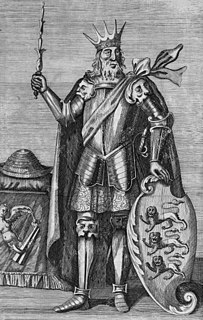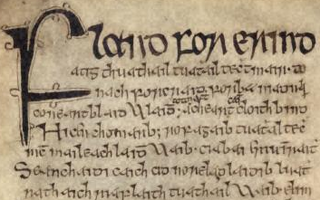
Brian Boru was an Irish king who ended the domination of the High Kingship of Ireland by the Uí Néill and probably ended Viking invasion/domination of Ireland. Brian built on the achievements of his father, Cennétig mac Lorcain, and especially his elder brother, Mathgamain. Brian first made himself king of Munster, then subjugated Leinster, eventually becoming High King of Ireland. He was the founder of the O'Brien dynasty, and is widely regarded as one of the most successful and unifying monarchs in medieval Ireland.

The Battle of Clontarf took place on 23 April 1014 at Clontarf, near Dublin, on the east coast of Ireland. It pitted an army led by Brian Boru, High King of Ireland, against a Norse-Irish alliance comprising the forces of Sigtrygg Silkbeard, King of Dublin; Máel Mórda mac Murchada, King of Leinster; and a Viking army from abroad led by Sigurd of Orkney and Brodir of Mann. It lasted from sunrise to sunset, and ended in a rout of the Viking and Leinster armies.
Áed mac Néill, called Áed Findliath to distinguish him from his paternal grandfather Áed Oirdnide, was king of Ailech and High King of Ireland. He was also called Áed Olach according to Baile in Scáil, section 51. A member of the northern Uí Néill kindred of the Cenél nEógain, Áed was the son of Niall Caille.
Toirdhealbhach Mór Ua Conchobhair anglicised Turlough Mór O'Conor, was King of Connacht (1106–1156) and High King of Ireland.

The Kings of Ailech were the over-kings of the medieval Irish province of Ailech in north-western Ireland. It encompassed the territories of the Cenél nEógain and Cenél Conaill. After the battle of Cloítech in 789 its kings were exclusively from the Cenél nEógain. The royal fort for Ailech was the Grianan of Aileach, a hillfort on top of Greenan Mountain in modern-day County Donegal, Republic of Ireland.

Domhnall Ua Lochlainn, also known as Domhnall Mac Lochlainn, was king of the Cenél Eogain, over-king of Ailech, and alleged High King of Ireland.

The history of Ireland 800–1169 covers the period in the history of Ireland from the first Viking raids to the Norman invasion. The first two centuries of this period are characterised by Viking raids and the subsequent Norse settlements along the coast. Viking ports were established at Dublin, Wexford, Waterford, Cork and Limerick, which became the first large towns in Ireland.
The Kings of Uisnech were of the Uí Néill and one of its major southern branches, the Clann Cholmáin. The Hill of Uisnech is located in what is now County Westmeath, and was in early historic Ireland considered as the area where all five provinces met.
McLoughlin is one of nearly two dozen Anglicisms for three Gaelic-Irish surnames: Mac/Nic Lochlainn, Ó/Ní Maoilsheachlainn, and Mac/Nic Lochnaigh.

Flann Sinna, also known as Flann mac Máel Sechnaill, was the son of Máel Sechnaill mac Máele Ruanaid of Clann Cholmáin, a branch of the Southern Uí Néill. He was King of Mide from 877 onwards and is counted as a High King of Ireland. His mother Land ingen Dúngaile was a sister of Cerball mac Dúnlainge, King of Osraige.

Máel Sechnaill mac Domnaill, also called Máel Sechnaill Mór or Máel Sechnaill II, was King of Mide and High King of Ireland. His great victory at the Battle of Tara against Olaf Cuaran in 980 resulted in Gaelic Irish control of the Kingdom of Dublin.
Donnchadh Donn mac Flainn was High King of Ireland and King of Mide. He belonged to Clann Cholmáin, a branch of the southern Uí Néill.
Domhnall ua Néill was High King of Ireland from 956 to 980.

Corcomroe is a barony in County Clare, Ireland. It is the southern half of the Gaelic tuath of Corco Modhruadh.
Flaithbertach Ua Néill was king of Ailech, a kingdom of north-west Ireland. He abdicated in 1030 and undertook a pilgrimage to Rome, for which reason he was known as Flaithbertach an Trostáin. Following the death of his son Áed in 1033, Flaithbertach left his retirement and resumed the leadership of the Northern Uí Néill.
Ruaidrí Ua Conchobair, called Ruaidrí na Saide Buide was King of Connacht, perhaps twice.
Bé Binn inion Urchadh was a Princess of the Uí Briúin Seóla and Queen of Thomond.
The Abbot of Clonard was the monastic head of Clonard Abbey, which is in modern-day County Meath, Ireland. The abbey was founded by Saint Finnian in the early sixth century. After the death of Saint Finnian, the abbots bore the title "Comarbai Finnéin". However, the title was ambiguous, since it may refer to the abbots of Moville, County Down, founded by Finnian nepos Fiatach. The abbots of Clonard were sometimes called 'coarbs of Finnian and Mo Cholmóc'. Until the early twelfth century, a few of the abbots and some others at Clonard Abbey were consecrated bishops, but this did not necessarily mean they were bishops of Clonard, since the diocese of Clonard was not established until the Synod of Rathbreasail in 1111.
Ó Troighthigh is a Gaelic-Irish surname, meaning descendant of foot-soldier.